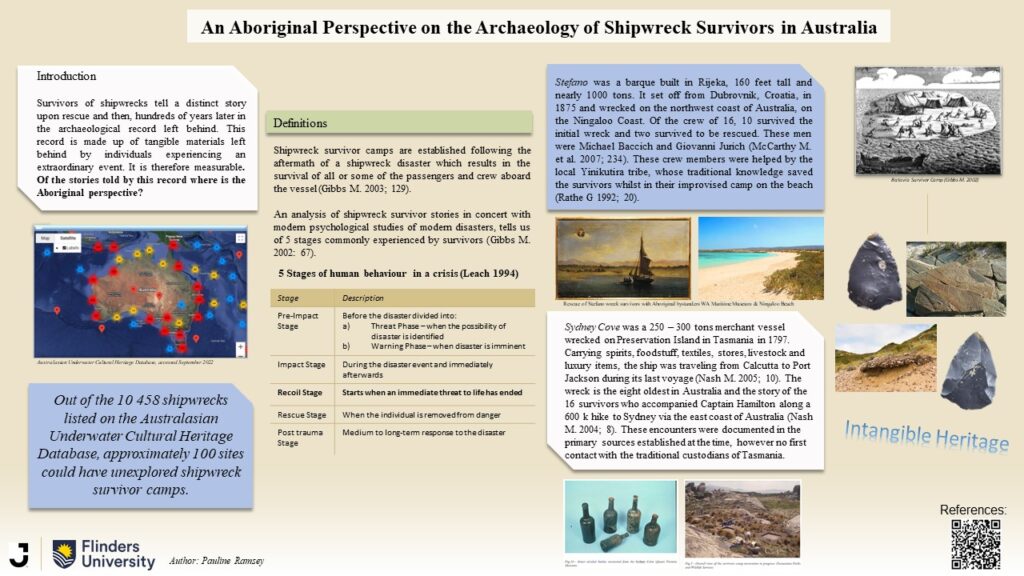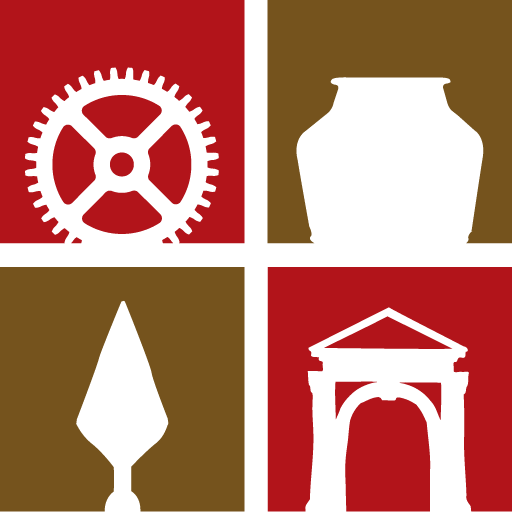During the 2022 Australasian Society for Historical Archaeology (ASHA) conference in Russell, New Zealand, I was fortunate enough to present a poster detailing an essay I wrote for my Australian Maritime Archaeology class at Flinder’s University. I was inspired by the findings of Michael Nash during his extensive works on the shipwreck Sydney Cove, found on Preservation Island, Tasmania (2005). The subsequent research outlined the findings both of the wreck and its associated shipwreck survivor camp. Among the bottles, ceramics and tools uncovered in the camp, I found that no detailed considerations of the Aboriginal presence had been made at this site. Possible mention of the survivor camp as a form of contact site was made only in a Monograph Series. In this document, the presence of the European survivors on Preservation Island may have impacted later Indigenous communities in stories, arts and technology after their departure (Nash M. 2005; 15). Having read this, I wanted to know more about the possible interactions early survivors of shipwrecks might have had with local Aboriginal communities and how this might be reflected in the archaeological record. Surely a coastal landing site would garner an Aboriginal presence due to the site’s strategic location for accessing maritime resources? Such a presence, for instance, is outlined in the survivor accounts of Stefano, a Croatian barque, shipwrecked on the Ningaloo Coast in north-western Australia (Rathe G 1992; 20). The historical source, being Father Stjepan Skurla who wrote the survivor’s story shortly after their rescue in 1876, outlines an early encounter between the shipwreck survivors and a local family group from the Yinikutira tribe at their improvised shelter. The survivors observed the group walk to the shore and efficiently gather small crabs and clams. They carried spears and “short, curved sticks”, and wore no clothing (Rathe G 1992; 20).
Further research into the status of research of shipwreck survivor camps found that such questions on the Aboriginal impact on shipwreck survivor camps had started to be raised in 1997 with the establishment of the ‘Australian Contact Shipwreck Program’ (McCarthy M. 2008). This program endeavoured to explore the insights of Aboriginal groups towards survivors of shipwrecks. This was inspired by the accumulated findings of the Austro-Hungarian barque Stefano, the VOC ship Zuytdorp and the German seaplane Atlantis (McCarthy M. 2008; 202). A database was created containing all known European and Asian shipwrecks where survivors have encountered Indigenous groups in Western Australia, along with another list of shipwrecks where survivors could have encountered Aboriginal groups but failed to record these interactions (Silvester L. 1998;1, McCarthy M. 2008; 203). Unfortunately, only one stage of the program was completed in a number of states across the country and to varying degrees of success. Much remains to be accomplished due to the immense amount of data needed to be reviewed (McCarthy M. 2008; 209). Out of the 10,458 shipwrecks listed on the Australasian Underwater Cultural Heritage Database, it is likely that approximately 1.36% of them have resulted in shipwreck survivor camps in Australasia. This is based on the estimates of Michael Nash from his study in Tasmania of Sydney Cove (2005; 9). However, as is clear by the published findings of this program, it is unlikely that the story of shipwreck survivors exists within a vacuum of purely environmentally deterministic behaviour and European cultural impacts. It is a reasonable assumption that for some of these survivors, encounters with Aboriginal peoples and cultures could have occurred but not have been recorded (Sylvester 1998; 8).
In all, I have found that in the case of the terrestrial sites known as ‘shipwreck survivor camps’, the Aboriginal footprint remains to be fully considered within the archaeological record. This bias fails to consider the material remains left behind by Aboriginal groups who have utilised the landscape long before the arrival of European shipwreck survivors, as well as the possible intangible heritage associated with the ocean and land.

References:
McCarthy M. 2008. The Australian Contact Shipwrecks Program. In Strangers on the Shores: Early Coastal Contact in Australia, edited by Veth P., Sutton P., Neale M., 202-210. Published by National Museum of Australia.
Nash M. 2005. Investigation of a survivor camp from the Sydney Cove shipwreck. Bulletin of The Australasian Institute for Maritime Archaeology 29, 9-24.
Silvester L. 1998. Strangers on the Shore Shipwrecks Survivors and their Contact with Aboriginal Groups in Western Australia 1628-1956. Report for the Department of Maritime Archaeology Western Australia Maritime Museum, No 146.
Rathe G. 1992. The Wreck of the Barque Stefano off the Northwest Cape of Australia in 1874. Edinburgh: Canongate Press.

